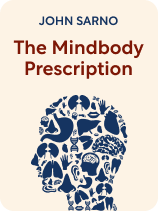

This article is an excerpt from the Shortform book guide to "The Mindbody Prescription" by John Sarno. Shortform has the world's best summaries and analyses of books you should be reading.
Like this article? Sign up for a free trial here.
What are the best psychosomatic pain treatment strategies? How can you heal emotion-driven chronic pain?
Psychosomatic pain treatment involves learning to identify repressed emotions and reflect on them in moments of pain. By learning how to do this, you can decrease the appearance of your symptoms.
Learn more about how to heal from psychosomatic illness by reading more.
How to Treat Psychosomatic Pain
Since it can be challenging to “just change” your mindset around your pain, here are four more concrete psychosomatic pain treatment strategies to try:
1) Overcome Your Brain’s Distractive Tactics
When you experience pain, deliberately focus your attention on your emotions. This can be difficult because pain is such an effective distractor, and because your mind is so resistant to acknowledging or processing your repressed emotions. However, you have to fight against your brain’s natural tendencies and redirect your attention to the source of the problem. When pain arises, ask yourself: “What rage or other difficult emotion am I unconsciously experiencing right now?” In dealing with pain from migraines, some found that this question alone could provide some immediate relief from pain.
(Shortform note: It might feel unnatural to disregard your physical pain. Pain, after all, is an adaptive response that developed to help us survive. However, this applies to acute pain, an immediate feeling of pain that occurs in response to a potentially harmful stimulus. This method deals with chronic pain, which, according to experts, has no survival value. As you employ these strategies, it’s important to distinguish between chronic pain—which is a distraction from your emotions—and acute pain—which is a necessary survival mechanism that you shouldn’t ignore.)
2) Make a List of the Sources of Your Repressed Emotions
Create a list of all the pressures you feel in your life, because these form a large portion of your rage. Also, consider what aspects of your childhood may have instilled some residual anger in you. Write out all the things that worry you or stress you out, then identify which ones are within your control and which ones aren’t. For those that are within your control, take some action to resolve them. For those that aren’t, accept them as reality, but refuse to let them cause you further pain.
(Shortform note: If you need additional help coping with and accepting the sources of your anger, consider a treatment like rational emotive therapy. This method focuses on helping you deal with emotions in a healthy way through strategies like improving social skills and conflict resolution skills, reframing troubling events, humor, and meditation. The treatment has a particular emphasis on acceptance, which could make it especially well-suited to people who struggle with accepting the stressors beyond their control.)
3) Communicate With Your Brain
Talk directly to your brain. Tell it that you know what it’s trying to do and you know it’s just a harmless distraction. You might even shout if it feels better to do so. You can also explicitly order your brain to increase its circulation to the affected muscles. Research supports the idea that you can communicate directly with your brain in this way.
(Shortform note: While talking to or shouting at your brain may help you confront its distractive tactics, it’s important to avoid slipping into negative self-talk. The way you talk to yourself can have a direct impact on your self-esteem, mental health, sense of control, and your pain levels. So, treat yourself with compassion as you communicate with your brain to tell it to stop distracting you or increase your blood flow.)
4) Make Time to Reflect
Set aside time each day to reflect on your pain and its purpose. Curing your TMS pain requires a conscious effort that you have to make time for, especially if you’re a particularly busy person (and people with the personality traits that tend to accompany TMS are often very busy people).
(Shortform note: Research shows that people tend to prioritize tasks with close deadlines over more important tasks with less immediate deadlines. Even though caring for your body is extremely important, this method may be difficult to implement because it doesn’t have a clear deadline. To help you prioritize it, consider adding a designated time slot to your schedule every day to work on your TMS, and try to eliminate other tasks you don’t need to do in order to free up more time in your day.)
What You Don’t Need to Do
There are also some things you don’t need to do to treat your pain.
Don’t Try to Change Your Personality
While the personality traits listed earlier in the guide tend to correlate with TMS, you can’t and shouldn’t change who you are. Curing your pain is a matter of accepting these aspects of yourself, not altering them.
(Shortform note: While the general understanding at the time that this theory originated was that personality couldn’t be changed, more recent research has shown that it is possible to alter personality traits. It’s not easy, though, and usually requires a lot of time and effort. Unless your personality traits are causing other problems in your life, your energy may be better spent accepting your traits than changing them.)
Don’t Try to Eliminate Stress From Your Life
Pressure leads to pain, and stress leads to pressure. Eliminating stress from your life is impossible, so make it your goal to change how you process and express stress. This way, you can keep it from causing rage to accumulate in your unconscious mind.
(Shortform note: In addition to these tips, experts offer plenty more advice on how to keep stress from ruling your life. Strong social support is particularly important—research shows that support from others reduces your body’s stress response to difficult situations. Other people can also help comfort you when you are feeling stressed. Reducing stress where it’s possible can also help. If your job is stressing you out, consider a job change or asking others for help. If you find yourself in a state of unusually high stress, try taking a break by postponing tasks you don’t have to do right now, and engage in self-care and non-stressful activities.)
Don’t Try to Change Your Lifestyle
Drastic lifestyle changes are often impossible or unsustainable, and usually, the goal in pain treatment is to return to the activities you enjoy.
Once your pain has gotten better, eliminate the fear you have of exercise, recreation, or the other things you’ve been told by doctors to avoid. Fear of injury keeps your attention focused on your body, but because your pain is emotionally induced, you don’t need to worry about hurting yourself. However, experts suggest waiting a few weeks after you’ve accepted the TMS diagnosis before you resume your physical activities. While exercising won’t cause damage, if your pain is still at a high level, you’ll likely have trouble keeping your mind off of it while you’re doing these activities. Therefore, it’s better to give your brain time to rewire itself and wait for the stress-associated pain to abate.
(Shortform note: Research supports the suggestion that chronic pain rewires the brain. In a process called central sensitization, the brain continues to perceive pain in the absence of a painful stimulus. This is because the brain has adapted to react to potentially painful stimuli, so eventually even something like a gentle touch can feel agonizing. Gradually returning to normal activities can reteach the brain to respond normally to stimuli. However, because this process takes time, doing too much too quickly can increase pain, suggesting that it’s important to take your time.)
Exercise: Overcome Your TMS Symptoms
Consider how TMS might be manifesting in your life, and how you could use this advice to treat their effects.
- Identify a symptom you’ve been experiencing that doesn’t seem to have a clear cause. How does this symptom manifest? This might include pain, gastrointestinal issues, allergies, dizziness, and so on.
- Use this advice to identify the root cause of this symptom. What emotions are you repressing that could be causing it? What pressures could be causing these emotions?
- Now that you’ve identified a potential cause of your symptom, write what you can do about it. If this is a stressor that’s within your control, make a plan for how you’ll reduce its impact. If you’re experiencing a lot of job pressure, for example, consider how you might ask for additional support from your coworkers or boss. If the stressor is beyond your control, acknowledge it, but resolve to stop letting it cause physical symptoms in you.
- Make a plan for what you’ll do the next time you experience this symptom. This might include telling your brain that you know it’s just distracting you with physical symptoms and using your brain’s power to overcome them. For example, you might need to command your brain to increase blood flow to a certain area, or tell it to stop distracting you with stomach problems. Remember this for when the symptom recurs.

———End of Preview———
Like what you just read? Read the rest of the world's best book summary and analysis of John Sarno's "The Mindbody Prescription" at Shortform.
Here's what you'll find in our full The Mindbody Prescription summary:
- A look at the chronic pain epidemic that's plaguing the Western world
- That the key to solving your pain is resolving your emotional tensions
- Why modern medicine doesn't recognize mindbody connection






